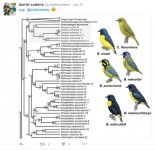andrew147
Well-known member
It seems that for the most part, existing generic splits are 4-7 million years old. A simple solution would be: older than that, different genera, younger same genera. In between, case by case depending on continuity, homogeneity, comparison of splits with close relatives and what the split looks like (twiggy branching or not). A couple of very homogenous genera that have early splits are kept together and a few splits that are very young are also kept because of rapid radiation (i. e. Galápagos finches)...
I'd like to see a similar approach applied consistently across whole of Aves (e.g.):
- genus at least 5 million years old;
- family c. 30 million years old;
- order c. 65 million years old.







